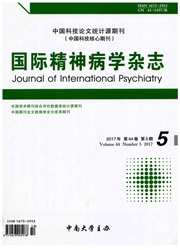

 中文摘要:
中文摘要:
目的研究慢性氯胺酮依赖者脑灰质改变情况。方法采用基本体素的形态学分析方法对41名氯胺酮依赖者和44名未使用任何成瘾物质的健康志愿者进行两组之间的脑灰质体积比较。结果与对照组相比,氯胺酮依赖组的双侧额叶区(左额上回和右额中回)灰质体积下降(P〈0.05,纠正后,cluster水平);氯胺酮使用的时间(月)与双侧额叶灰质体积呈负相关,而估计的氯胺酮使用总量只和左额上回的灰质体积呈负相关。结论本研究首次报道了氯胺酮依赖者的双侧额叶灰质体积下降,并与使用时间和使用量有关。
 英文摘要:
英文摘要:
Objective Using three - dimensional magnetic resonance imaging to assess volumetric abnormalities of grey matter in chronic ketamine dependent subjects. Methods We used voxel based morphometry in conjunction with statistical parametric mapping on the structural magnetic resonance images of ketamine - dependent (n =41 ) and drugnaive control individuals (n =44) to assess differences between the two groups in gray matter volume. Results We found a decrease in gray matter volume in bilateral frontal (left superior frontal and right middle frontal) cortex of ketamine patients in comparison to controls (P 〈0. 05 corrected for multiple comparisons at cluster - level). Also, we found that the duration (months) of ketamine use was negatively correlated with gray matter volume in bilateral frontal cortex while the estimated total lifetime ketamine consumption was only negatively correlated with gray matter volume in left superior frontal cortex. Conclusions This is the first voxel - based morphometry study showing reduction of frontal gray matter volume in patients with ketamine dependence and showing the correlation of duration of ketamine use and cumulative doses of ketamine with decrease of frontal gray matter volume. Brain structural study of the affected areas in patients with ketamine dependence might better guide future research into the poorly understood condition of ketamine addiction and its correlates of schizophrenia.
 同期刊论文项目
同期刊论文项目
 同项目期刊论文
同项目期刊论文
 Differences between smokers and non-smokers inregional gray matter volumes: a voxel-based morphometr
Differences between smokers and non-smokers inregional gray matter volumes: a voxel-based morphometr Conditioned Place Preference Associated with Level of Palmitoylation of PSD-95 in Rat Hippocampus an
Conditioned Place Preference Associated with Level of Palmitoylation of PSD-95 in Rat Hippocampus an The dopamine D(2) partial agonist and antagonist terguride decreases heroin self-administration on f
The dopamine D(2) partial agonist and antagonist terguride decreases heroin self-administration on f Chronic administration of ketamine mimics the perturbed sense of body ownership associated with schi
Chronic administration of ketamine mimics the perturbed sense of body ownership associated with schi Gender differences in prevalence and correlates of antisocial personality disorder among heroin depe
Gender differences in prevalence and correlates of antisocial personality disorder among heroin depe The association of 5-HTR2A-1438A/G, COMTVal158Met, MAOA-LPR, DATVNTR and 5-HTTVNTR gene polymorphism
The association of 5-HTR2A-1438A/G, COMTVal158Met, MAOA-LPR, DATVNTR and 5-HTTVNTR gene polymorphism Leukocyte mitochondrial DNA copy number in blood is not associated with major depressive disorder in
Leukocyte mitochondrial DNA copy number in blood is not associated with major depressive disorder in Differences between smokers and non-smokers in regional gray matter volumes: a voxel-based morphomet
Differences between smokers and non-smokers in regional gray matter volumes: a voxel-based morphomet The C(-1562)T polymorphism of matrix metalloproteinase-9 gene is associated with schizophrenia in Ch
The C(-1562)T polymorphism of matrix metalloproteinase-9 gene is associated with schizophrenia in Ch White matter microstructural abnormalities in patients with late-onset schizophrenia identified by a
White matter microstructural abnormalities in patients with late-onset schizophrenia identified by a Decrease in Temporal Gyrus Gray Matter Volume in First-Episode, Early Onset Schizophrenia: An MRI St
Decrease in Temporal Gyrus Gray Matter Volume in First-Episode, Early Onset Schizophrenia: An MRI St Abnormal anterior cingulum integrity in first episode, early-onset schizophrenia: A diffusion tensor
Abnormal anterior cingulum integrity in first episode, early-onset schizophrenia: A diffusion tensor Symptoms of disordered eating, body shape, and mood concerns in male and female Chinese medical stud
Symptoms of disordered eating, body shape, and mood concerns in male and female Chinese medical stud A Pilot Study of Life Events and Mood Disorders: Self-Report Survey in Chinese Heroin-Dependent Indi
A Pilot Study of Life Events and Mood Disorders: Self-Report Survey in Chinese Heroin-Dependent Indi 期刊信息
期刊信息
